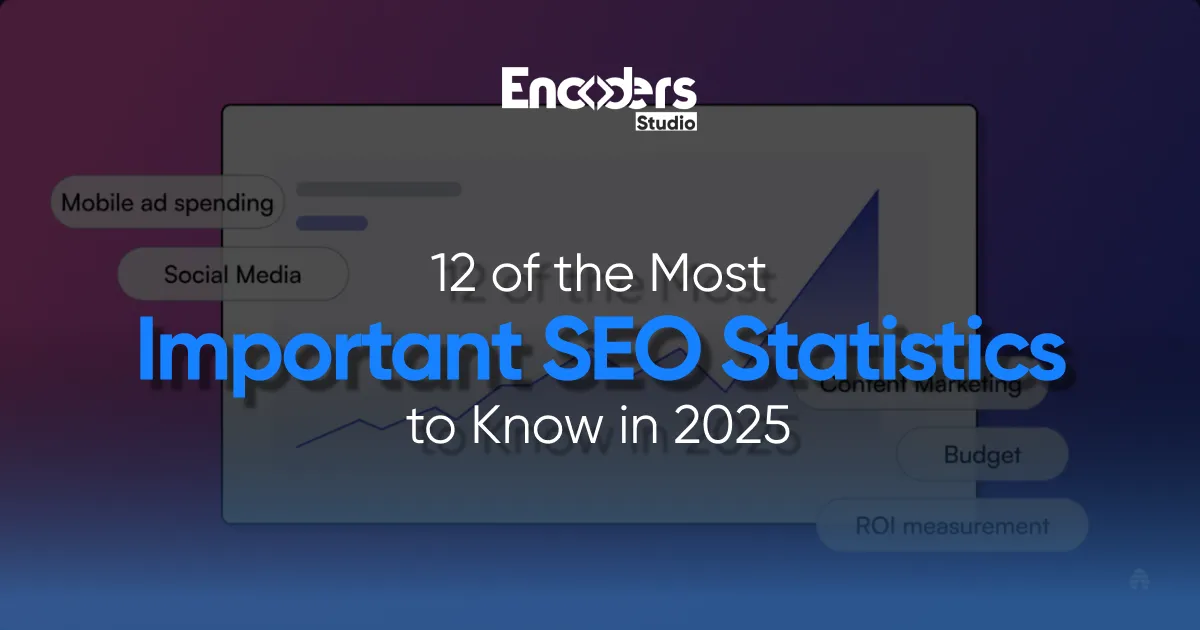SEO has evolved dramatically over the years. What worked five years ago can now leave your site trailing behind. With constant algorithm updates, shifting consumer behavior, and increased competition, staying on top of SEO trends has become more than just a strategy. Whether you’re managing an e-commerce store, targeting local SEO, or striving for top organic rankings, keeping up with the latest SEO statistics is the only way to ensure long-term success. Your site may struggle to gain visibility, leaving you vulnerable to your competitors who are already ahead of the game.
1. Organic Search Dominance
The power of organic search cannot be overstated. 53% of all website traffic comes from organic search. This makes it the single most important channel for digital discovery in 2025. Even more telling, organic search results account for 94% of all clicks, demonstrating that paid search captures only a tiny fraction of user attention and engagement.
What makes organic search so powerful?
- Massive Traffic Potential: This channel represents the largest opportunity for consistent, sustainable visibility online, with more than half of all website traffic coming from organic search.
- High-Intent Traffic: Users actively searching for information, products, or services have higher conversion potential than those who encounter passive advertising.
- Long-Term Value: Unlike paid advertising that stops delivering the moment your budget runs out, strong organic rankings continue generating traffic without ongoing costs.
- Trust Factor: Users trust organic results more than paid advertisements, with 94% of clicks going to organic listings rather than ads.
- First-Page Necessity: 75% of users never go past the first page, making high rankings essential for visibility.
Note: These seo statistics highlight an uncomfortable truth: businesses neglecting organic search are invisible to more than half their potential audience. When customers can’t find you, they find your competitors instead.
2. Google’s Market Share
The search engine landscape continues to be dominated by one player. Google remains the undisputed leader, holding 89.74% of the global search market share. On mobile devices, this dominance increases to an even more commanding 93.88%.
Why does Google’s dominance matter for your SEO strategy?
- Prioritization Necessity: Prioritizing for Google first is the logical approach for most businesses seeking search visibility with nearly 90% market share.
- Mobile Dominance: Google’s even higher market share on mobile devices (93.88%) reflects the company’s leadership in mobile search experience.
- Algorithm Focus: Most SEO professionals primarily track and adapt to Google’s algorithm updates rather than other search engines.
- Tool Ecosystem: Google provides the most comprehensive set of SEO and analytics tools, from Search Console to Analytics 4.
- Regional Variations: While Google dominates globally, businesses targeting specific markets like China or Russia may need separate strategies for regional search engines.
Note: These Google SEO statistics explain why most SEO strategies prioritize Google’s algorithm changes and ranking factors. While other search engines shouldn’t be completely ignored, the numbers make it clear where your optimization priorities should lie.
3. User Behavior on Search Engines
Understanding how users interact with search results is critical for SEO success. One of the most crucial statistics to understand is that 75% of users never go past the first page of search results. This means ranking on page two might as well be ranking nowhere at all for most businesses.
What factors drive user behavior in search results?
- Top Position Dominance: The click-through rate (CTR) for the first organic result sits at 39.8%, which jumps to 42.9% if it’s a featured snippet.
- Steep Engagement Drop-off: By the time you reach position ten at the bottom of page one, the CTR drops below 2%.
- Trust in Higher Rankings: Users instinctively trust Google’s algorithm to present the most relevant results first, leading to higher click rates for top positions.
- Impatience Factor: The average user spends less than 15 seconds deciding which result to click, favoring options at the top of the page.
- Mobile Interface Limitations: On mobile devices, users see fewer results without scrolling, making top positions even more critical.
Note: These user behavior seo statistics explain why businesses invest significant resources to climb even a single position in search results, especially when moving from position #2 to position #1 can nearly double your traffic.
4. Search Volume and Activity
The scale of search activity continues to grow at an astonishing rate. Google processes over 8.5 billion searches per day, approximately 99,000 searches per second. The average internet user performs 3 to 4 searches daily, making search engines an integral part of daily decision-making.
What’s behind these massive search numbers?
- Integration into Daily Life: Search engines have become the default tool for answering questions, finding products, and making decisions.
- Mobile Accessibility: Smartphones allow people to search anytime, anywhere, driving up overall search volume.
- Voice Search Growth: The convenience of voice assistants has added another avenue for search, further increasing total queries.
- Diverse Query Types: Searches now encompass everything from simple questions to complex research, shopping comparisons, and local service needs.
- New Query Generation: Approximately 15% of daily searches have never been searched before, showing the constantly evolving nature of search behavior.
Note: These search volume seo statistics highlight both the opportunity and the challenge for businesses. The potential audience is enormous, but so is the competition for their attention.
5. ROI and Business Impact
The financial case for SEO investment has never been stronger. The average return on investment (ROI) for a high-quality SEO campaign stands at 748%, meaning businesses earn $7.48 for every $1 spent on SEO. For small businesses, the ROI can exceed 400%.
Why does SEO deliver such impressive returns?
- Cumulative Value: Unlike paid advertising, SEO efforts build upon themselves over time, creating lasting value rather than temporary visibility.
- Multiple Traffic Streams: Effective SEO creates visibility across numerous keywords and topics, generating diverse traffic sources.
- Targeting High-Intent Users: SEO connects businesses with users actively searching for their products, services, or information.
- Reduced Acquisition Cost: Over time, the cost per acquisition through organic search decreases as rankings improve without proportional cost increases.
- Brand Authority Building: Strong organic visibility enhances brand recognition and trustworthiness beyond direct traffic benefits.
Note: These ROI seo statistics explain why businesses that initially hesitate at SEO costs often become the strongest advocates once they experience the sustained traffic and conversion benefits of ranking well.
6. Mobile and Local SEO
The connection between online search and physical business has never been stronger. 46% of all Google searches seek local information, reflecting consumers’ use of search engines to find nearby solutions. Even more compelling, 78% of location-based mobile searches result in an on-site purchase.
What’s driving the local search revolution?
- Mobile Dominance: People frequently search for local businesses while on the go, with 92.3% of users accessing the internet via mobile phones.
- Immediacy of Intent: Local searches often indicate immediate purchase intent, with 29% of local searches leading to store visits within 24 hours.
- “Near Me” Search Growth: Searches including “near me” have grown exponentially as users expect location-relevant results.
- Map Integration: The prominence of Google Maps in search results has made local pack listings a critical visibility factor.
- Review Importance: 86% of consumers read reviews for local businesses, making review management a core component of local SEO.
Note: These local SEO statistics show that businesses optimizing for “near me” searches, maintaining accurate Google Business Profiles, and collecting positive reviews gain significant advantages in their local markets. The connection between digital search and physical commerce continues to strengthen in 2025.
7. Voice Search Growth
The way people search is fundamentally changing. Voice search continues gaining traction, with 90% of people finding it easier than typing out queries. This shift is changing how users interact with search engines and how businesses need to optimize their content.
What’s driving voice search adoption?
- Convenience Factor: Speaking is naturally faster than typing, especially on mobile devices or when users’ hands are occupied.
- Smart Speaker Proliferation: The growing presence of smart speakers in homes has normalized voice-based interactions with technology.
- Natural Language Processing: Improvements in AI have made voice recognition more accurate and responsive to conversational queries.
- Longer, Conversational Queries: Voice searches average 29 words compared to just 3-4 words for typed searches, changing the keyword landscape.
- Question-Based Formatting: Voice searches typically take the form of complete questions rather than fragmented keyword phrases.
Note: These voice search seo statistics indicate the growing importance of optimizing for both text and voice-based discovery as we move through 2025. Businesses that adapt their content to answer conversational questions gain an advantage in this growing search segment.
8. Content Length and Performance
Despite claims about shortening attention spans, quality long-form content is more valuable than ever. Long-form content (over 3,000 words) continues to outperform shorter content, generating 3x more traffic, receiving 4x more shares, and earning 3.5x more backlinks compared to shorter content.
Why does comprehensive content perform better?
- Thorough Topic Coverage: Longer content can address multiple aspects of a topic, answering more potential user questions in one resource.
- Greater Keyword Opportunity: Comprehensive content naturally incorporates more keyword variations and related terms.
- Authority Signaling: In-depth exploration of topics signals expertise to both users and search algorithms.
- Higher Value Perception: Users often perceive detailed content as more valuable, increasing sharing and linking behavior.
- Lower Bounce Rates: Content that thoroughly answers users’ questions keeps them engaged longer, reducing bounce rates.
Note: These content-related seo statistics explain why businesses investing in thorough, well-researched content consistently outperform those creating thin, superficial pages that fail to fully address user needs. High-quality content remains one of Google’s top three ranking factors in 2025.
9. Zero-Click Searches
A new challenge is emerging in the search landscape. The rise of zero-click searches, where users find answers directly on the search results page without clicking through to any website, presents new challenges for traffic generation strategies.
What’s behind the zero-click search phenomenon?
- Featured Snippet Expansion: Google’s featured snippets aim to answer queries directly in the search results, reducing the need to click through.
- Knowledge Panels: Information boxes provide quick facts, definitions, and basic data without requiring website visits.
- Local Packs: Business information displayed directly in search results often satisfies user needs without website visits.
- Quick Answers: Simple questions increasingly receive direct answers at the top of search results.
- SERP Features Growth: The expansion of interactive elements in search results keeps users engaged within Google’s ecosystem.
Note: These evolving seo statistics require businesses to reconsider success metrics beyond simple rankings, focusing instead on capturing attention within increasingly competitive search result pages.
10. Backlinks and Link Building
The foundation of search authority remains consistent. Despite numerous algorithm updates, backlinks remain fundamental to SEO success. Pages ranking #1 have 3.8x more backlinks than positions 2–10, clearly demonstrating the continued importance of link building.
What makes backlinks still crucial in 2025?
- Authority Signaling: Links from reputable sites act as “votes of confidence” that help search engines identify trustworthy content.
- Discovery Mechanism: Backlinks help search engines discover new content and understand how pages are related.
- Competitive Differentiator: With 95% of pages having zero backlinks, quality link profiles create significant competitive advantages.
- Relevance Indicator: Contextual links from related sites help search engines understand your content’s topic and relevance.
- Traffic Generation: Quality backlinks not only improve rankings but also drive direct referral traffic.
Note: These link-related Google SEO statistics explain why businesses continue to invest in content worthy of being referenced and cited by other reputable websites in their industries.
11. Generative AI’s Limited Impact
Despite predictions about AI disrupting search behavior, the data tells a different story. Traditional search engines have maintained their central role, with over 99% of generative AI users still relying on traditional search engines alongside AI tools, rather than replacing one with the other.
Why has AI not replaced traditional search?
- Complementary Tools: Users view AI assistants and search engines as serving different purposes rather than substitutes.
- Trust Verification: Many users double-check AI responses through traditional search, creating a hybrid information-seeking behavior.
- Specialized Needs: Search engines remain superior for certain query types, particularly for finding recent information or specific resources.
- Visual Result Preference: Search provides a variety of result formats (images, videos, maps) that most AI tools cannot match.
- Habitual Behavior: Deeply ingrained search habits continue to drive user behavior despite new technology options.
Note: These AI-related seo statistics indicate that while adaptation is necessary, the core principles of search visibility remain as valuable as ever in 2025. Businesses should integrate AI optimization into their strategies without abandoning traditional SEO fundamentals.
12. E-commerce SEO and Featured Snippets
Online shopping continues to be driven by search. For online retailers, ecommerce SEO statistics reveal that 67% of ecommerce purchases begin with a search engine visit, underlining the critical importance of ranking well for product-related terms.
Meanwhile, featured snippets capture prime attention in search results, with an impressive CTR of 42.9%. Similarly, rich results capture 58% of clicks, making these enhanced listings critical targets for SEO efforts.
Check out our PPC management services to boost product visibility alongside SEO efforts.
What’s driving e-commerce search success?
- Product Search Competition: Shopping searches starting on Google (49%) nearly match those starting on Amazon (46%), creating a two-front battle for visibility.
- Enhanced Results Advantage: Product listings with rich results (pricing, availability, reviews) capture significantly more clicks than plain listings.
- Mobile Shopping Growth: The continued rise of mobile shopping makes visibility in mobile search results increasingly important.
- User Experience Impact: Sites with poor page experience see cart abandonment rates of 88%, highlighting the technical side of e-commerce SEO.
- Structured Data Necessity: Product schema implementation has become essential for standing out in competitive e-commerce searches.
Note: These ecommerce SEO statistics demonstrate why online retailers invest heavily in product page optimization, structured data implementation, and user experience improvements to convert searchers into buyers.
Your Call for Change
The right knowledge empowers you to optimize your website, improve user experience, and ultimately, secure your position at the top of search rankings. As SEO continues to evolve, make sure you’re armed with the latest insights to drive your online success. Stay informed, stay competitive, and keep pushing your site’s performance forward.
Excited to take your business to the next level? At Encoders Studio, we specialize in creating top-notch digital content and innovative marketing strategies tailored to your needs. Let’s work together to make your brand’s online presence unbeatable.
Contact us today and see how we can help you grow.
FAQs
How can I improve my website’s organic ranking with SEO?
Focus on keyword optimization, content quality, building authoritative backlinks, and improving your site’s user experience. Regularly updating content and ensuring your site is mobile-friendly also boosts organic ranking.
What are the latest trends in local SEO for 2025?
Local SEO is becoming increasingly focused on Google Business Profile optimizations, customer reviews, and local link-building strategies. Voice search and location-based targeting will continue to rise in importance as well.
How do backlinks influence SEO rankings?
Backlinks from authoritative, relevant sites boost your domain authority and improve search rankings. Quality over quantity matters, as search engines prioritize links from credible sources.
What are the key differences between e-commerce SEO and local SEO?
Ecommerce SEO focuses on product optimization, user experience, and conversion rates. Local SEO is centered around location-specific search results, map listings, and local content to help businesses appear in local searches.




